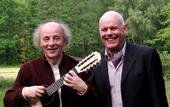Myspace Layouts at Pimp-My-Profile.com / Autumn Mosaic
PIARANGO is formed from the words "Piano" and "Charango". The name is not only a play on words but also, and more importantly, refers to the special and unique "timbre" or "sound colours" which result from this combination. The two instruments unite to form a third.
It is perhaps difficult to imagine a more surprising combination of musical instruments as those featured in PIARANGO. The piano, symbol "par exellence" of an established European musical tradition, together with the charango, a small mandolin-like instrument from the Andes mountains of South America. Yet the real surprise is how well and unique they sound together.
On the occasion of PIARANGO..S debut concert ( Berlin, 2001) the leading German daily, "Frankfurter Allgemeine" hailed the event as "extraordinary....due not only to the originality of the line-up and quality of the music" but as well " the sheer virtuosity and exciting temperament of the performers, José Hernan Cibils (piano) and Patrick Zeoli (charango) "
Since then PIARANGO have enjoyed a steadily growing reputation throughout Europe and have performed to date to audiences in Germany, Poland, Italy, Spain, Switzerland, Czech Republic, England, Ireland and Estonia. Their concerts have included venues such as the Mikulov Palace (Czech Republic), Vilandi Festival (Estonia), The Nefretete Museum (Berlin) the "Sagrada Familia" church (Barcelona), the monastery of Montserrat, (Catalonia), always drawing an enthusiastic and excited reponse from both critics and public alike. ..."the excitement of the audience knew no boundaries..." (Neue Presse, July 2003).
The music featured by PIARANGO is principally from Argentina and Bolivia and is as varied and contrasting as the landscapes and cultures contained within these remarkable nations. From the traditional songs and dances of the high Andes to the dynamic, pulsating rhythmns of own compositions and improvisations, PIARANGO present a unique musical panorama from one of the most fascinating and captivating regions of our planet.
PIARANGO is made up of José Hernan Cibils (piano) and Patrick Zeoli (Charango)
The Charango
The piano, of course, requires no introduction to musical audiences anywhere in the world. The charango, on the other hand, remains for many a little known curiosity and up until today has made little impact outside the world of Andean music. This very special instrument is a direct descendant of the european Baroque Guitar which was brought to the New World by the early Spanish soldiers and colonizers in the 17th and 18th centuries. Up until then, the instruments used by virtually all native American cultures consisted only of aerophones ( wind instruments) and percussion, the concept of stringed instruments was completly unknown. As with so much else, the indigenous inhabitants of the Americas were to develop over time their own versions of the european instruments wich they first heard in the hands of the Spanish newcomers and also to incorporate many aspects of the music they heard into their own musical tradition.
The charango today is a five-course ( 10 string ) instrument which resembles a small guitar. However the many different styles of playing along with a wide range of possible tunings have endowed it with a unique sound and musical personality which is far removed from that of the contemporary guitar. The first charangos appeared already towards the end of the 18th century in the highland regions of Potosi in Alto Peru ( present-day Bolivia) and since then the instrument has evolved into an indispensable element of Bolivian music. In the course of the 20th century the charango has been incorporated into into the popular musical cultures of neighbouring countries such as Peru, Chile and Argentina.
PATRICK ZEOLI IN JAPAN
In July 2008 Patrick hat played charango and guitar toguether with the Miharu Ensamble in Japan, with works of Carlos Guastavino, José H. Cibils and others.
More information here
and here
